Spatiotemporal Variation of Evapotranspiration and Its Driving Factors in the Urumqi River Basin
Abstract
1. Introduction
2. Materials and Methods
2.1. Study Area
2.2. Data Sources
2.2.1. ET Data
2.2.2. Land-Cover Data
2.2.3. Terrain Data
2.2.4. Other Data
2.3. Methods
2.3.1. Trend Analysis Method
2.3.2. ET Dynamic Analysis Method
2.3.3. Average ET
2.3.4. Analysis of Land-Use Transfer Matrix
2.3.5. Optimal Parameters-Based Geographical Detector Model
3. Results
3.1. Characteristics of ET Changes
3.1.1. Interannual and Seasonal Variation of ET
3.1.2. Changes in ET Spatial and Temporal Dynamics
3.2. Correlation Analysis of ET Influencing Factors
3.2.1. Correlation with Land-Use Factors
3.2.2. Correlation with Topography Factors
3.2.3. Relative Contribution of Influences to ET
4. Discussion
4.1. Analysis of the Causes of Spatiotemporal Variation in ET Characteristics
4.2. Analysis of Impact Factors
4.3. Shortcomings and Research Significance
5. Conclusions
- (1)
- The average basin evapotranspiration has been increasing for 20 years, and the annual basin evapotranspiration variation ranges from 126.57 to 247.66 mm. The seasonal scale of ET is mainly summer > spring > autumn > winter. At the spatial scale, the surface ET in the Urumqi River Basin is generally high upstream (south) and low downstream (north). The multi-year ET average in the basin is 22.74–479.33 mm, with significant spatial distribution differences. The severe and slight decrease in average ET is mainly concentrated in the downstream Midong area and the cultivated land area around Wujiaqu. The ET in the upstream presents a significant increasing trend, while other areas remain unchanged or record a slight increase.
- (2)
- From the analysis of land-use changes, it can be seen that grassland and cultivated land account for a relatively large proportion of the area of the Urumqi River Basin. Taking 2020 as an example, the average proportions of various types of land use are 58.25% and 15.67%, respectively. Among the six land-cover types, the type with the highest ET mean value was forest land, followed by grassland, cropland, and water bodies. The effect of elevation on ET was more consistent, with a significant increase in ET with increasing altitude.
- (3)
- Analysis of the factors influencing the spatial and temporal variation of ET revealed that these varied from year to year. Temperature, DEM, NDVI, and precipitation have been having a crucial influence on ET in the Urumqi River Basin. However, the influence of two-factor combinations on the spatial distribution of ET was found to be stronger than any individual factors, especially the interactions among vegetation, temperature, precipitation, and land use.
Author Contributions
Funding
Data Availability Statement
Acknowledgments
Conflicts of Interest
References
- Zhan, M.; Wang, G.; Hagan, D.F.T.; Waheed, U.; Giri, K.; Lu, J.; Li, S. Impacts of Vegetation Changes on Land Evapotranspiration in China During 1982–2015. Front. Environ. Sci. 2022, 10, 17. [Google Scholar] [CrossRef]
- Deng, O.; Li, Y.Q.; Li, R.S.; Yang, G.B. Estimation of Forest Ecosystem Climate Regulation Service Based on Actual Evapotranspiration of New Urban Areas in Guanshanhu District, Guiyang, Guizhou Province, China. Sustainability 2022, 14, 10022. [Google Scholar] [CrossRef]
- Hao, X.M.; Fan, X.; Zhao, Z.Y.; Zhang, J.J. Spatiotemporal Patterns of Evapotranspiration in Central Asia from 2000 to 2020. Remote Sens. 2023, 15, 1150. [Google Scholar] [CrossRef]
- Zhu, X.Q.; Jin, X.M.; Zhang, X.C.; Zhang, J. Regional analysis of evapotranspiration changes in an arid river basin using satellite observations. Arid. Land Res. Manag. 2021, 35, 251–275. [Google Scholar] [CrossRef]
- Yassen, A.N.; Nam, W.H.; Hong, E.M. Impact of climate change on reference evapotranspiration in Egypt. Catena 2020, 194, 11. [Google Scholar] [CrossRef]
- Pourmansouri, F.; Rahimzadegan, M. Evaluation of vegetation and evapotranspiration changes in Iran using satellite data and ground measurements. J. Appl. Remote Sens. 2020, 14, 21. [Google Scholar] [CrossRef]
- Hou, P.S.; Fadzil, L.M.; Manickam, S.; Al-Shareeda, M.A. Vector Autoregression Model-Based Forecasting of Reference Evapotranspiration in Malaysia. Sustainability 2023, 15, 3675. [Google Scholar] [CrossRef]
- Liu, Z.H.; Jing, D.; Han, Y.; Yu, J.X.; Lu, T.G.; Zhangzhong, L. Spatiotemporal Distribution Characteristics and Influencing Factors Analysis of Reference Evapotranspiration in Beijing-Tianjin-Hebei Region from 1990 to 2019 under Climate Change. Sustainability 2022, 14, 6277. [Google Scholar] [CrossRef]
- Hu, X.H.; Chen, M.T.; Liu, D.; Li, D.; Jin, L.; Liu, S.H.; Cui, Y.L.; Dong, B.; Khan, S.; Luo, Y.F. Reference evapotranspiration change in Heilongjiang Province, China from 1951 to 2018: The role of climate change and rice area expansion. Agric. Water Manag. 2021, 253, 14. [Google Scholar] [CrossRef]
- Zhao, F.B.; Ma, S.; Wu, Y.P.; Qiu, L.J.; Wang, W.K.; Lian, Y.Q.; Chen, J.; Sivakumar, B. The role of climate change and vegetation greening on evapotranspiration variation in the Yellow River Basin, China. Agric. For. Meteorol. 2022, 316, 14. [Google Scholar] [CrossRef]
- Keszeliova, A.; Vyleta, R.; Danacova, M.; Hlavcova, K.; Sleziak, P.; Gribovszki, Z.; Szolgay, J. Detection of Changes in Evapotranspiration on a Catchment Scale Under Changing Climate Conditions in Selected River Basins of Slovakia. Slovak J. Civ. Eng. 2022, 30, 55–63. [Google Scholar] [CrossRef]
- Bai, P.; Liu, X.M.; Zhang, Y.Q.; Liu, C.M. Assessing the Impacts of Vegetation Greenness Change on Evapotranspiration and Water Yield in China. Water Resour. Res. 2020, 56, 20. [Google Scholar] [CrossRef]
- Chang, Y.P.; Ding, Y.J.; Zhao, Q.D.; Qin, J.; Zhang, S.Q. Elevation-dependent changes in the trend of reference evapotranspiration in the Tibetan Plateau during 1960–2017. Int. J. Climatol. 2023, 43, 2077–2095. [Google Scholar] [CrossRef]
- Gan, G.J.; Wu, J.L.; Hori, M.; Fan, X.W.; Liu, Y.W. Attribution of decadal runoff changes by considering remotely sensed snow/ice melt and actual evapotranspiration in two contrasting watersheds in the Tienshan Mountains. J. Hydrol. 2022, 610, 12. [Google Scholar] [CrossRef]
- Jin, X.M.; Guo, R.H.; Xia, W. Distribution of Actual Evapotranspiration over Qaidam Basin, an Arid Area in China. Remote Sens. 2013, 5, 6976–6996. [Google Scholar] [CrossRef]
- Moiwo, J.P.; Tao, F.L. Contributions of precipitation, irrigation and soil water to evapotranspiration in (semi)-arid regions. Int. J. Climatol. 2015, 35, 1079–1089. [Google Scholar] [CrossRef]
- Wang, Y.; Liu, Y.B.; Jin, J.X.; Fan, X.W. Intra-Annual Variability of Evapotranspiration in Response to Climate and Vegetation Change across the Poyang Lake Basin, China. Remote Sens. 2022, 14, 885. [Google Scholar] [CrossRef]
- Yang, L.S.; Feng, Q.; Zhu, M.; Wang, L.M.; Alizadeh, M.R.; Adamowski, J.F.; Wen, X.H.; Yin, Z.L. Variation in actual evapotranspiration and its ties to climate change and vegetation dynamics in northwest China. J. Hydrol. 2022, 607, 13. [Google Scholar] [CrossRef]
- Zheng, Q.Z.; Hao, L.; Huang, X.L.; Sun, L.; Sun, G. Effects of Urbanization on Watershed Evapotranspiration and Its Components in Southern China. Water 2020, 12, 645. [Google Scholar] [CrossRef]
- Wang, Q.L.; Cheng, L.; Zhang, L.; Liu, P.; Qin, S.J.; Liu, L.; Jing, Z.X. Quantifying the impacts of land-cover changes on global evapotranspiration based on the continuous remote sensing observations during 1982-2016. J. Hydrol. 2021, 598, 14. [Google Scholar] [CrossRef]
- Wu, G.A.; Lu, X.C.; Zhao, W.; Cao, R.C.; Xie, W.Q.; Wang, L.Y.; Wang, Q.H.; Song, J.X.; Gao, S.B.; Li, S.G.; et al. The increasing contribution of greening to the terrestrial evapotranspiration in China. Ecol. Model. 2023, 477, 9. [Google Scholar] [CrossRef]
- Guo, Q.; Liang, J.N.; Cao, X.J.; Zhang, Z.D.; Zhang, L. Spatiotemporal Evolution of Evapotranspiration in China after 1998. Water 2020, 12, 3250. [Google Scholar] [CrossRef]
- Chen, D.T.; Liu, W.J.; Huang, F.R.; Li, Q.; Uchenna-Ochege, F.; Li, L.H. Spatial-temporal characteristics and influencing factors of relative humidity in arid region of Northwest China during 1966–2017. J. Arid. Land 2020, 12, 397–412. [Google Scholar] [CrossRef]
- Du, Y.; Zhao, J.; Huang, Q. Quantitative driving analysis of climate on potential evapotranspiration in Loess Plateau incorporating synergistic effects. Ecol. Indic. 2022, 141, 13. [Google Scholar] [CrossRef]
- Lin, N.; Jiang, R.Z.; Liu, Q.; Yang, H.; Liu, H.L.; Yang, Q. Quantifying the Spatiotemporal Variation of Evapotranspiration of Different Land Cover Types and the Contribution of Its Associated Factors in the Xiliao River Plain. Remote Sens. 2022, 14, 252. [Google Scholar] [CrossRef]
- Gu, J.H.; Xue, H.Z.; Dong, G.T.; Zhou, L.J.; Li, J.R.; Dang, S.Z.; Li, S.Z. Effects of NDVI/land-use on spatiotemporal changes of evapotranspiration in the Yellow River Basin. Arid. Land Geogr. 2021, 44, 158–167. [Google Scholar] [CrossRef]
- Ma, Y.L.; Niu, Z.R.; Zhang, R.; Sun, D.Y.; Chen, J.N.; Bai, Z.H. Temporal and Spatial Evolution and Driving Factors of Potential Evaportranspiration in Shule River Basin. Res. Soiland Water Conserv. 2022, 5, 350–357. [Google Scholar] [CrossRef]
- Ribolzi, O.; Lacombe, G.; Pierret, A.; Robain, H.; Sounyafong, P.; de Rouw, A.; Soulileuth, B.; Mouche, E.; Huon, S.; Silvera, N.; et al. Interacting land use and soil surface dynamics control groundwater outflow in a montane catchment of the lower Mekong basin. Agric. Ecosyst. Environ. 2018, 268, 90–102. [Google Scholar] [CrossRef]
- Bai, H.B.; Ming, Z.T.; Zhong, Y.L.; Zhong, M.; Kong, D.D.; Ji, B. Evaluation of evapotranspiration for exorheic basins in China using an improved estimate of terrestrial water storage change. J. Hydrol. 2022, 610, 16. [Google Scholar] [CrossRef]
- Huo, W.; Zhi, X.F.; Hu, S.Q.; Cai, W.Y.; Yang, F.; Zhou, C.L.; MamtiMin, A.; He, Q.; Pan, H.L.; Song, M.Q.; et al. Refined assessment of potential evapotranspiration in the tarim basin. Front. Earth Sci. 2022, 10, 13. [Google Scholar] [CrossRef]
- Wang, Y.X.; Ao, Y.H.; Li, Z.G. Evapotranspiration Characteristics of Different Oases and Effects of Human Activities on Evapotranspiration in Heihe River Basin. Remote Sens. 2022, 14, 6283. [Google Scholar] [CrossRef]
- Wang, K.X.; Zhang, Y.S.; Ma, N.; Guo, Y.H.; Qiang, Y.H. Cryosphere evapotranspiration in the Tibetan Plateau: A review. Sci. Cold Arid Reg. 2020, 12, 355–370. [Google Scholar] [CrossRef]
- Zhang, H.; Wang, L. Analysis of the variation in potential evapotranspiration and surface wet conditions in the Hancang River Basin, China. Sci. Rep. 2021, 11, 10. [Google Scholar] [CrossRef] [PubMed]
- Huai, B.J.; Wang, Y.T.; Li, Z.Q.; Sun, W.J.; Wang, X.Y. Glacier changes and its effect on water resources in Urumqi River Basin, Tianshan Mountains, China, from 1964 to 2014. Arab. J. Geosci. 2018, 11, 9. [Google Scholar] [CrossRef]
- Gao, C.H. Sedimentary facies changes and climatic-tectonic controls in a foreland basin, the Urumqi River, Tian Shan, Northwest China. Sediment. Geol. 2004, 169, 29–46. [Google Scholar] [CrossRef]
- Mamattursun, A.; Yang, H.; Ablikim, K.; Obulhasan, N. Spatiotemporal Evolution and Driving Forces of Vegetation Cover in the Urumqi River Basin. Int. J. Environ. Res. Public Health 2022, 19, 15323. [Google Scholar] [CrossRef]
- Shan, N.; Shi, Z.; Yang, X.; Gao, J.; Cai, D. Spatiotemporal trends of reference evapotranspiration and its driving factors in the Beijing-Tianjin Sand Source Control Project Region, China. Agric. For. Meteorol. 2015, 200, 322–333. [Google Scholar] [CrossRef]
- Yang, Q.; Wang, J.; Yang, D.; Yan, D.; Dong, Y.; Yang, Z.; Yang, M.; Zhang, P.; Hu, P. Spatial-temporal variations of reference evapotranspiration and its driving factors in cold regions, northeast China. Environ. Sci. Pollut. Res. 2022, 29, 36951–36966. [Google Scholar] [CrossRef]
- Che, X.H.; Zhang, H.K.; Sun, Q.; Ouyang, Z.T.; Liu, J.P. MODIS Evapotranspiration Downscaling Using a Deep Neural Network Trained Using Landsat 8 Reflectance and Temperature Data. Remote Sens. 2022, 14, 5876. [Google Scholar] [CrossRef]
- Chang, Y.P.; Ding, Y.J.; Zhao, Q.D.; Zhang, S.Q. Remote estimation of terrestrial evapotranspiration by Landsat 5 TM and the SEBAL model in cold and high-altitude regions: A case study of the upper reach of the Shule River Basin, China. Hydrol. Process. 2017, 31, 514–524. [Google Scholar] [CrossRef]
- Yang, J.; Huang, X. The 30 m annual land cover dataset and its dynamics in China from 1990 to 2019. Earth Syst. Sci. Data 2021, 13, 3907–3925. [Google Scholar] [CrossRef]
- Shen, Y.; Shaffer, S.J.; Jordan, R.L. Shuttle Radar Topography Mission (SRTM) flight system design and operations overview. In Proceedings of the Conference on Microwave Remote Sensing of the Atmosphere and Environment II, Sendai, Japan, 9–12 October 2000; pp. 167–178. [Google Scholar]
- van Zyl, J.J. The Shuttle Radar Topography Mission (SRTM): A breakthrough in remote sensing of topography. Acta Astronaut. 2001, 48, 559–565. [Google Scholar] [CrossRef]
- Amiri, M.; Jafari, R.; Tarkesh, M.; Modarres, R. Spatiotemporal variability of soil moisture in arid vegetation communities using MODIS vegetation and dryness indices. Arid Land Res. Manag. 2020, 34, 1–25. [Google Scholar] [CrossRef]
- Fan, D.; Chen, X.T.; Li, Y.L.; Du, K.; Liu, S.F.; Dang, S.Z.; Guo, P.; Dong, G.T. Spatio-temporal analysis of vegetation variation in the Jinghe River Basin. In Proceedings of the 4th International Conference on Sustainable Energy and Environmental Engineering (ICSEEE), Shenzhen, China, 20–21 December 2015; pp. 1058–1061. [Google Scholar]
- Lamchin, M.; Park, T.; Lee, J.Y.; Lee, W.K. Monitoring of Vegetation Dynamics in the Mongolia Using MODIS NDVIs and their Relationship to Rainfall by Natural Zone. J. Indian Soc. Remote Sens. 2015, 43, 325–337. [Google Scholar] [CrossRef]
- Peng, S.Z.; Ding, Y.X.; Liu, W.Z.; Li, Z. 1 km monthly temperature and precipitation dataset for China from 1901 to 2017. Earth Syst. Sci. Data 2019, 11, 1931–1946. [Google Scholar] [CrossRef]
- Peng, S.Z.; Ding, Y.X.; Wen, Z.M.; Chen, Y.M.; Cao, Y.; Ren, J.Y. Spatiotemporal change and trend analysis of potential evapotranspiration over the Loess Plateau of China during 2011-2100. Agric. For. Meteorol. 2017, 233, 183–194. [Google Scholar] [CrossRef]
- Peng, S.Z.; Gang, C.C.; Cao, Y.; Chen, Y.M. Assessment of climate change trends over the Loess Plateau in China from 1901 to 2100. Int. J. Climatol. 2018, 38, 2250–2264. [Google Scholar] [CrossRef]
- Zhao, X.W.; Gao, Q.; Yue, Y.J.; Duan, L.; Pan, S. A System Analysis on Steppe Sustainability and Its Driving Forces-A Case Study in China. Sustainability 2018, 10, 233. [Google Scholar] [CrossRef]
- Chen, Y.Z.; Lu, H.W.; Li, J.; Xia, J. Effects of land use cover change on carbon emissions and ecosystem services in Chengyu urban agglomeration, China. Stoch. Environ. Res. Risk Assess. 2020, 34, 1197–1215. [Google Scholar] [CrossRef]
- Wang, H.; Zhang, M.; Cui, L.; Yu, X. Spatial Heterogeneity in Sensitivity of Evapotranspiration to Climate Change. Pol. J. Environ. Stud. 2017, 26, 2287–2293. [Google Scholar] [CrossRef]
- Wang, J.; Chen, Y.Q.; Shao, X.M.; Zhang, Y.Y.; Cao, Y.G. Land-use changes and policy dimension driving forces in China: Present, trend and future. Land Use Policy 2012, 29, 737–749. [Google Scholar] [CrossRef]
- Wang, J.F.; Li, X.H.; Christakos, G.; Liao, Y.L.; Zhang, T.; Gu, X.; Zheng, X.Y. Geographical Detectors-Based Health Risk Assessment and its Application in the Neural Tube Defects Study of the Heshun Region, China. Int. J. Geogr. Inf. Sci. 2010, 24, 107–127. [Google Scholar] [CrossRef]
- Su, Y.; Li, T.X.; Cheng, S.K.; Wang, X. Spatial distribution exploration and driving factor identification for soil salinisation based on geodetector models in coastal area. Ecol. Eng. 2020, 156, 18. [Google Scholar] [CrossRef]
- de Oliveira, R.G.; Valle, L.C.G.; da Silva, J.B.; Espindola, D.; Lopes, R.D.; Nogueira, J.S.; Curado, L.F.A.; Rodrigues, T.R. Temporal trend changes in reference evapotranspiration contrasting different land uses in southern Amazon basin. Agric. Water Manag. 2021, 250, 14. [Google Scholar] [CrossRef]
- Li, X.Y.; Zou, L.; Xia, J.; Dou, M.; Li, H.W.; Song, Z.H. Untangling the effects of climate change and land use/cover change on spatiotemporal variation of evapotranspiration over China. J. Hydrol. 2022, 612, 13. [Google Scholar] [CrossRef]
- Eltarabily, M.G.; Abd-Elaty, I.; Elbeltagi, A.; Zelenakova, M.; Fathy, I. Investigating Climate Change Effects on Evapotranspiration and Groundwater Recharge of the Nile Delta Aquifer, Egypt. Water 2023, 15, 572. [Google Scholar] [CrossRef]
- Liu, W.; Yang, L.S.; Zhu, M.; Adamowski, J.F.; Barzegar, R.; Wen, X.H.; Yin, Z.L. Effect of Elevation on Variation in Reference Evapotranspiration under Climate Change in Northwest China. Sustainability 2021, 13, 10151. [Google Scholar] [CrossRef]
- Yang, Q.; Ma, Z.G.; Zheng, Z.Y.; Duan, Y.W. Sensitivity of Potential Evapotranspiration Estimation to the Thornthwaite and Penman-Monteith Methods in the Study of Global Drylands. Adv. Atmos. Sci. 2017, 34, 1381–1394. [Google Scholar] [CrossRef]
- Liu, Y.; Yu, E.T.; Yang, J.J.; Huang, W.J. Characteristics of Spatial and Temporal Variation of Actual Evapotranspiration in the arid Region of Northwest China from 1960-2019. Res. Soil Water Conserv. 2021, 28, 75–89. [Google Scholar] [CrossRef]
- Yuan, X.; Bai, J. Future Projected Changes in Local Evapotranspiration Coupled with Temperature and Precipitation Variation. Sustainability 2018, 10, 3281. [Google Scholar] [CrossRef]
- Zhu, L.; Wang, Q.P.; Wang, Y.; Zhao, K.M. Comparative analysis of two extreme blizzard processes in Urumqi. Torrential Rain Disasters 2020, 39, 225–233. [Google Scholar] [CrossRef]
- Yang, Y.G.; Zhao, C.Y.; Han, M.; Li, Y.K.; Yang, R.H. Temporal Patterns of Shrub Vegetation and Variation with Precipitation in Gurbantunggut Desert, Central Asia. Adv. Meteorol. 2015, 2015, 11. [Google Scholar] [CrossRef]
- Li, Q.; Chen, X.; Liu, Y.; Bao, A.M.; Veroustraete, F. Regional evapotranspiration retrieval in arid areas. J. Arid. Land Resour. Environ. 2012, 26, 108–112. [Google Scholar] [CrossRef]
- Deng, X.Y.; Liu, Y.; Liu, Z.H.; Yao, J.Q. Temporal-spatial dynamic change characteristics of evapotranspiration in arid region of Northwest China. Acta Ecol. Sin. 2017, 37, 2994–3008. [Google Scholar] [CrossRef][Green Version]
- Bian, Y.L.; Cao, H.T.; Zhang, H.M.; Huang, F.G. Analysis on Infiltration Capacity and Infiltration Reduction Effect of Muddy Water with Different Sediment Gradation under the Conditions of Irrigation. Yellow River 2015, 37, 145–148. [Google Scholar]
- Li, H.Y.; Chen, R.S.; Han, C.T.; Yang, Y. Evaluation of the Spatial and Temporal Variations of Condensation and Desublimation over the Qinghai-Tibet Plateau Based on Penman Model Using Hourly ERA5-Land and ERA5 Reanalysis Datasets. Remote Sens. 2022, 14, 5815. [Google Scholar] [CrossRef]
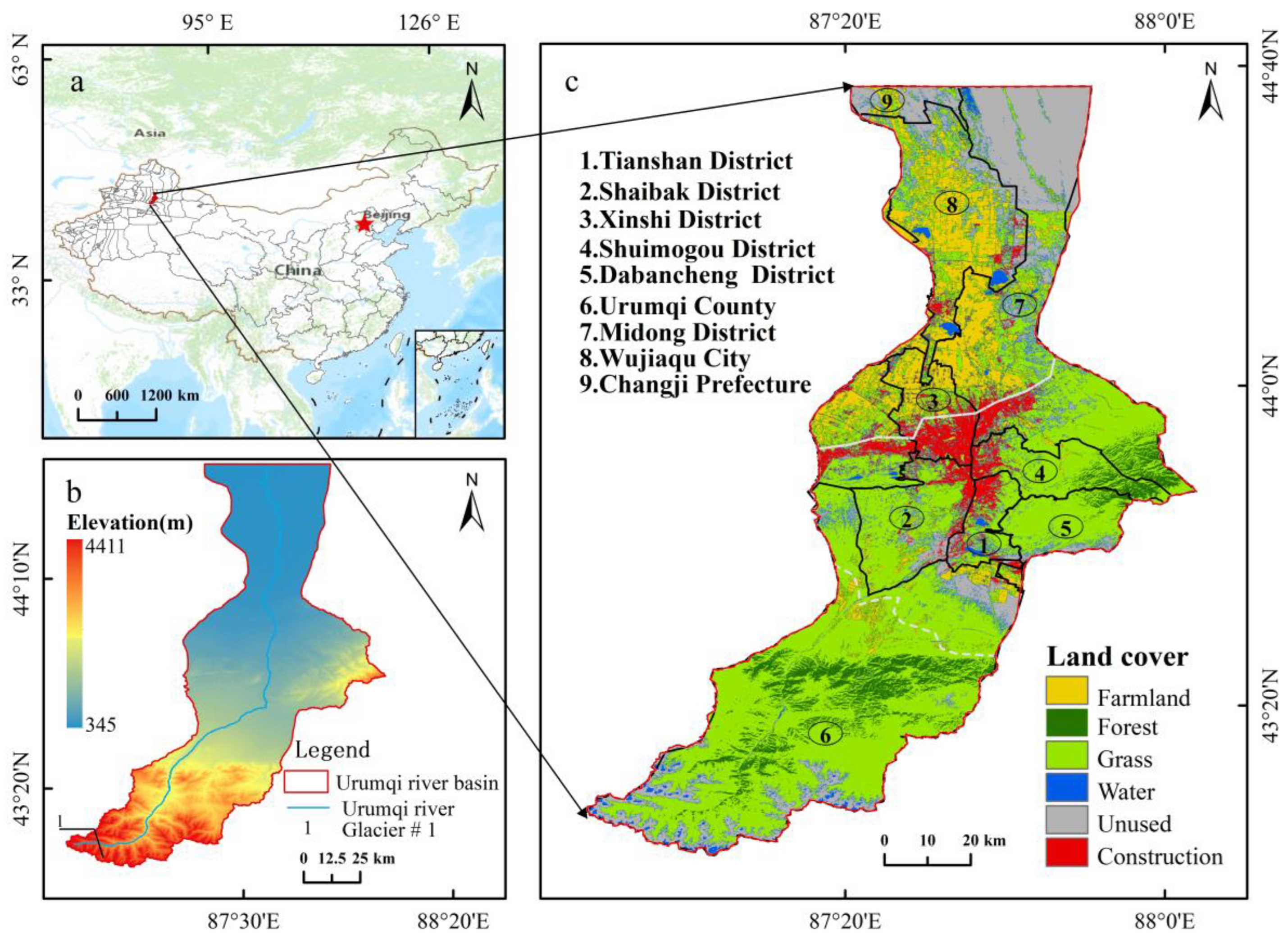
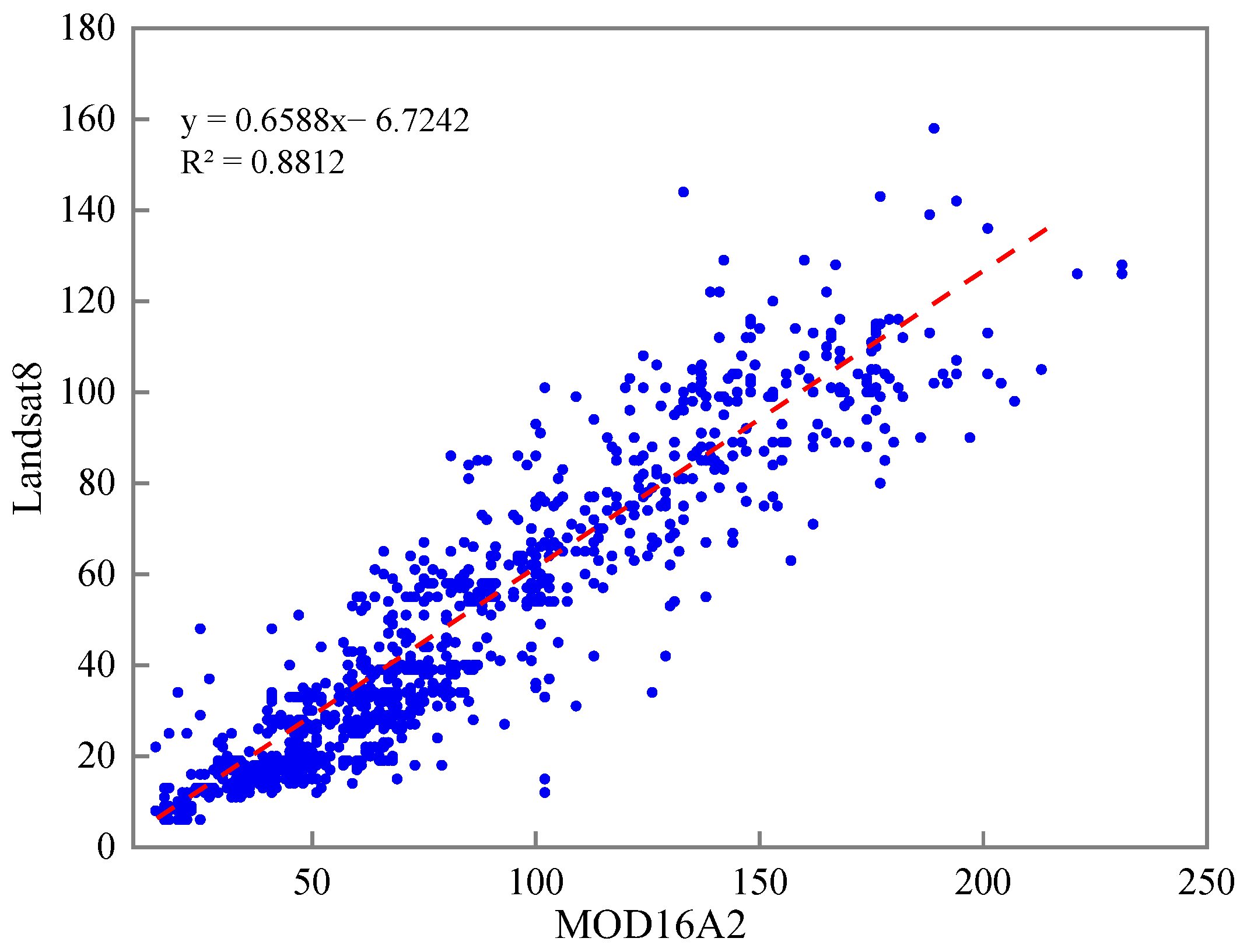
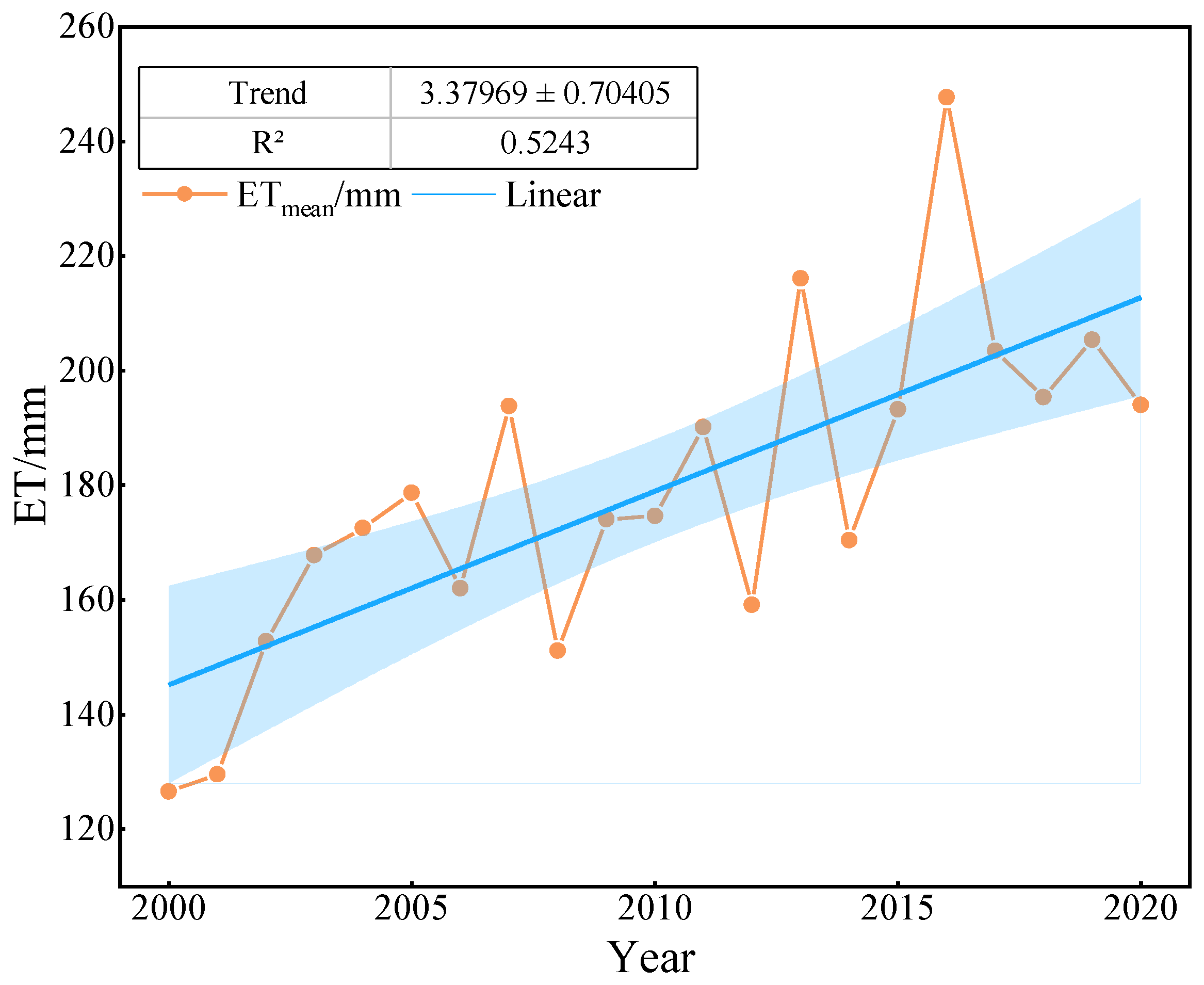
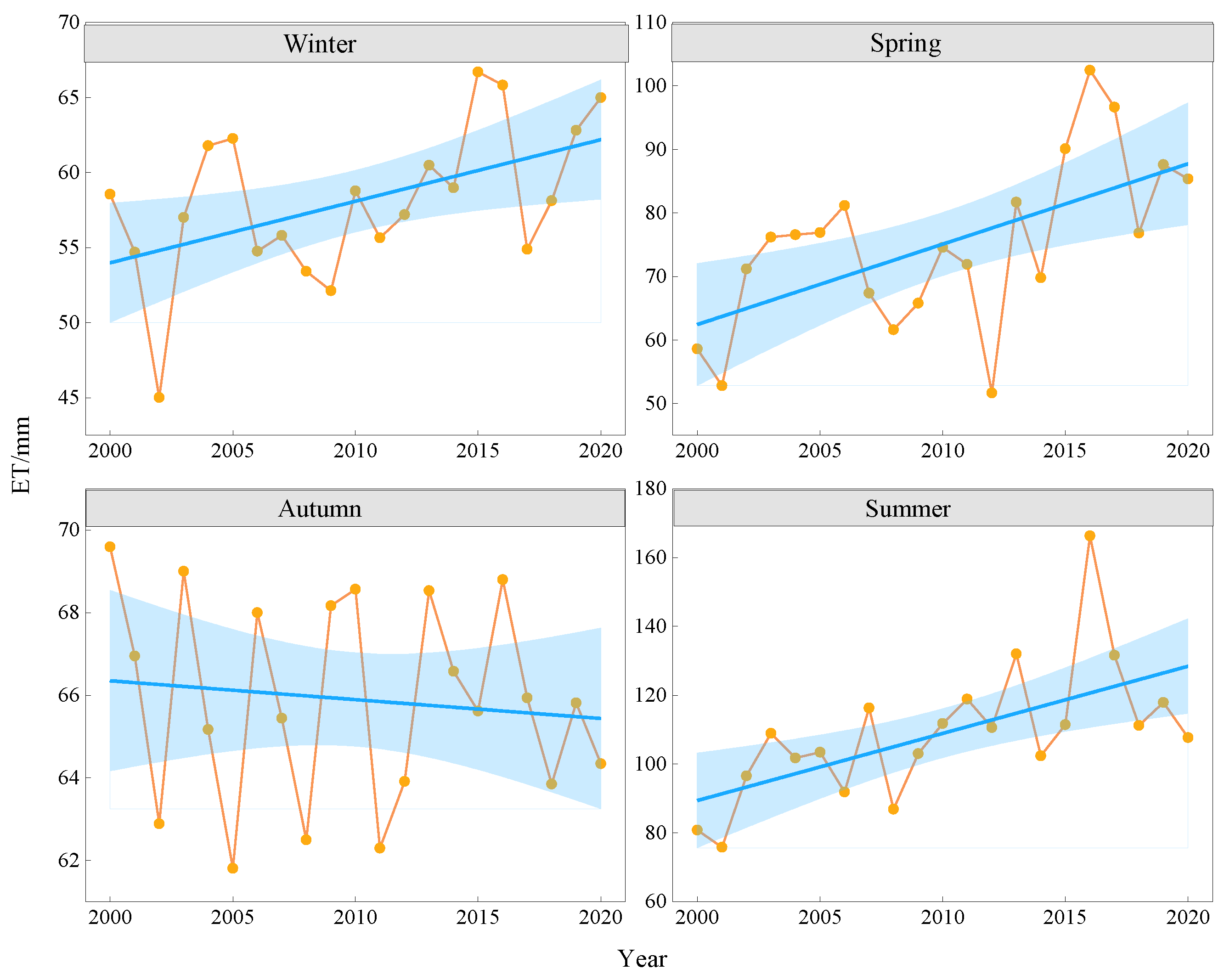
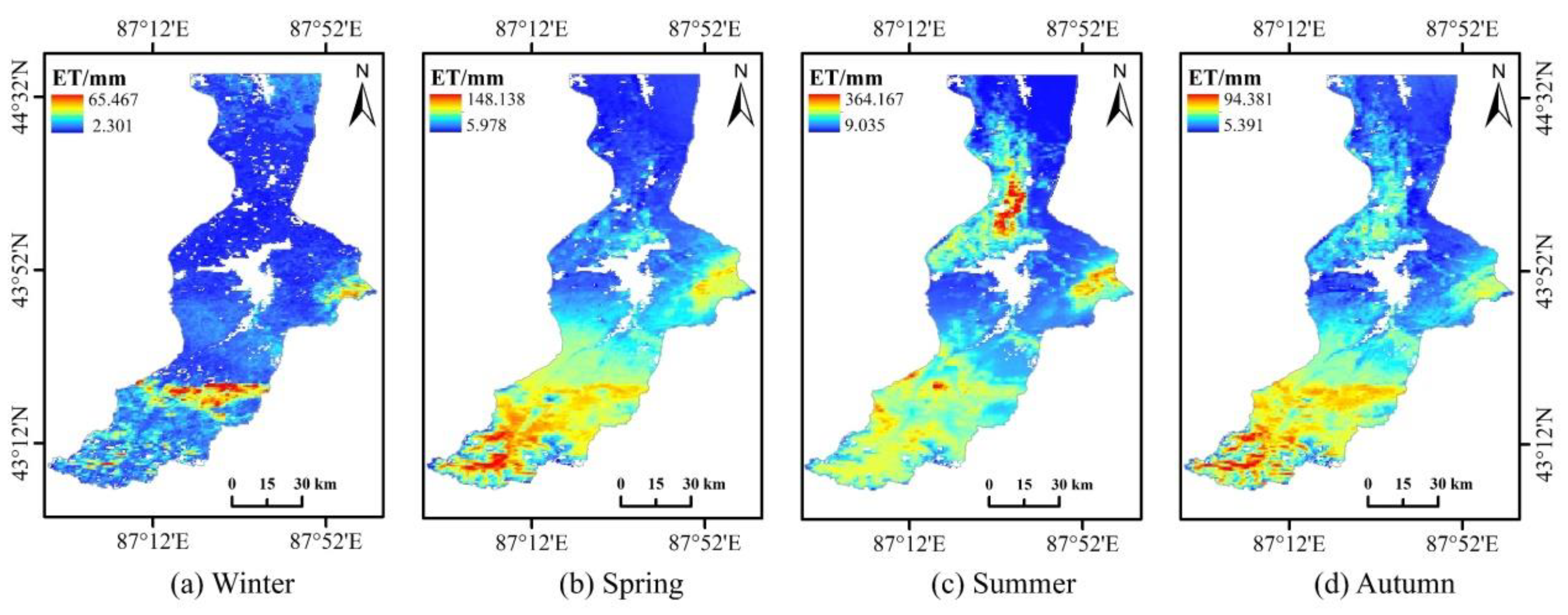
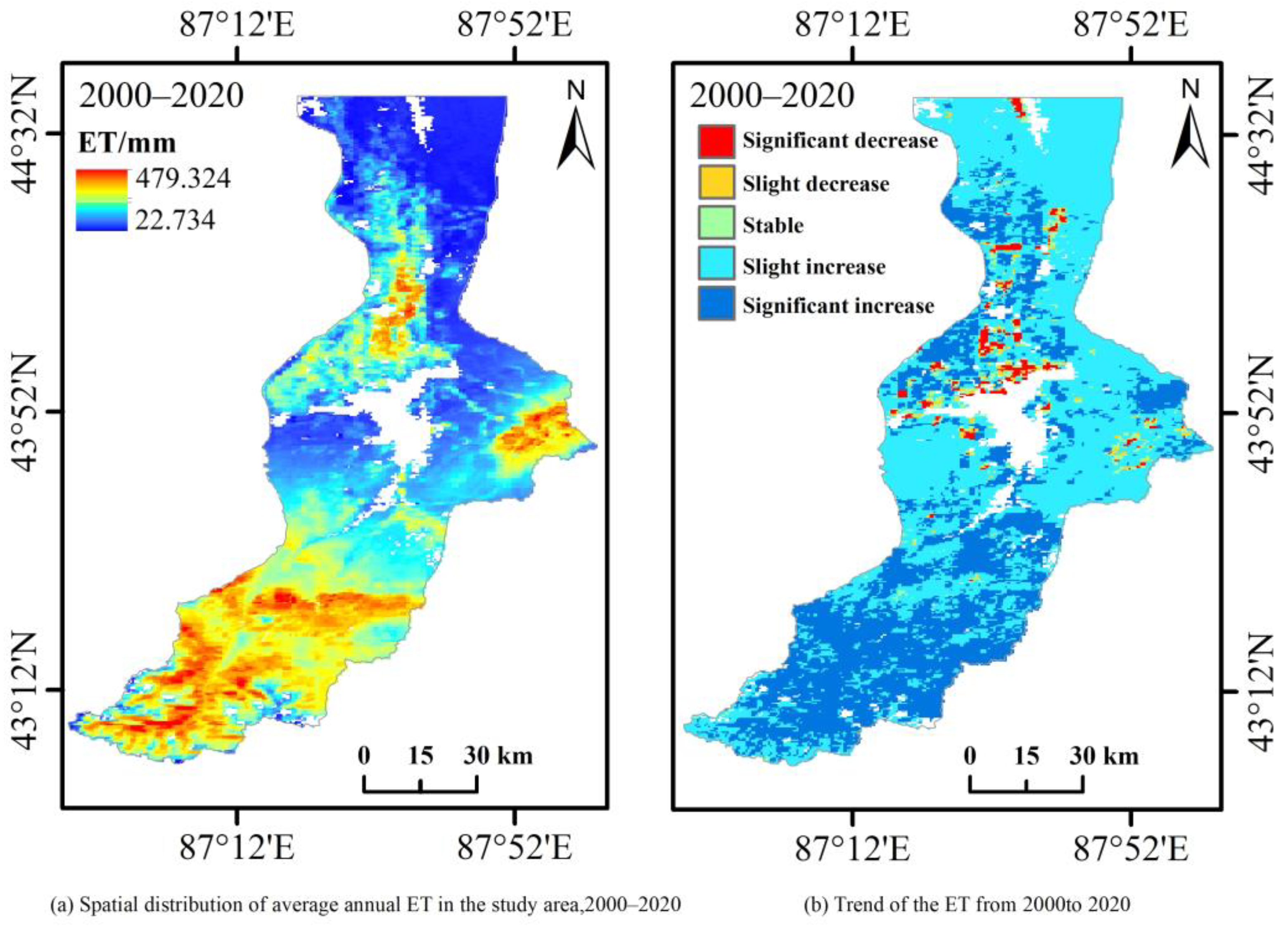

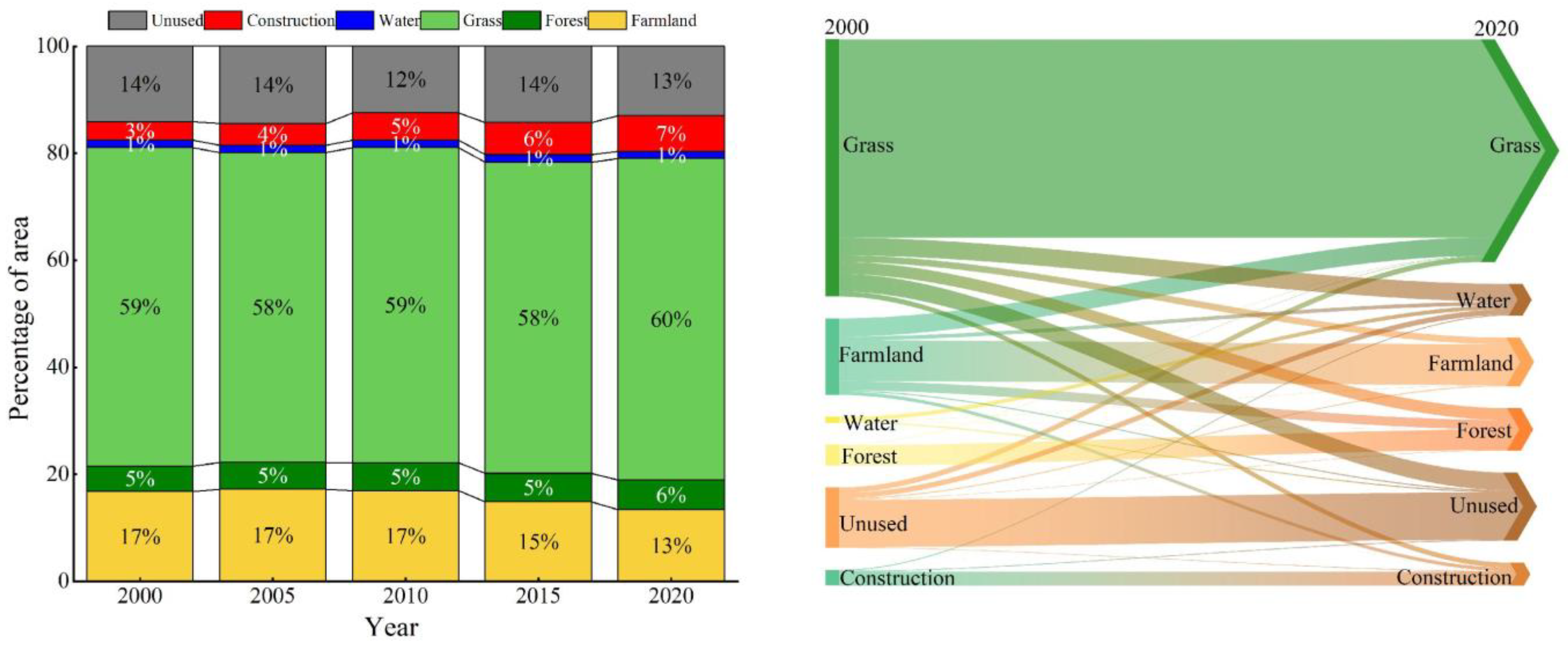
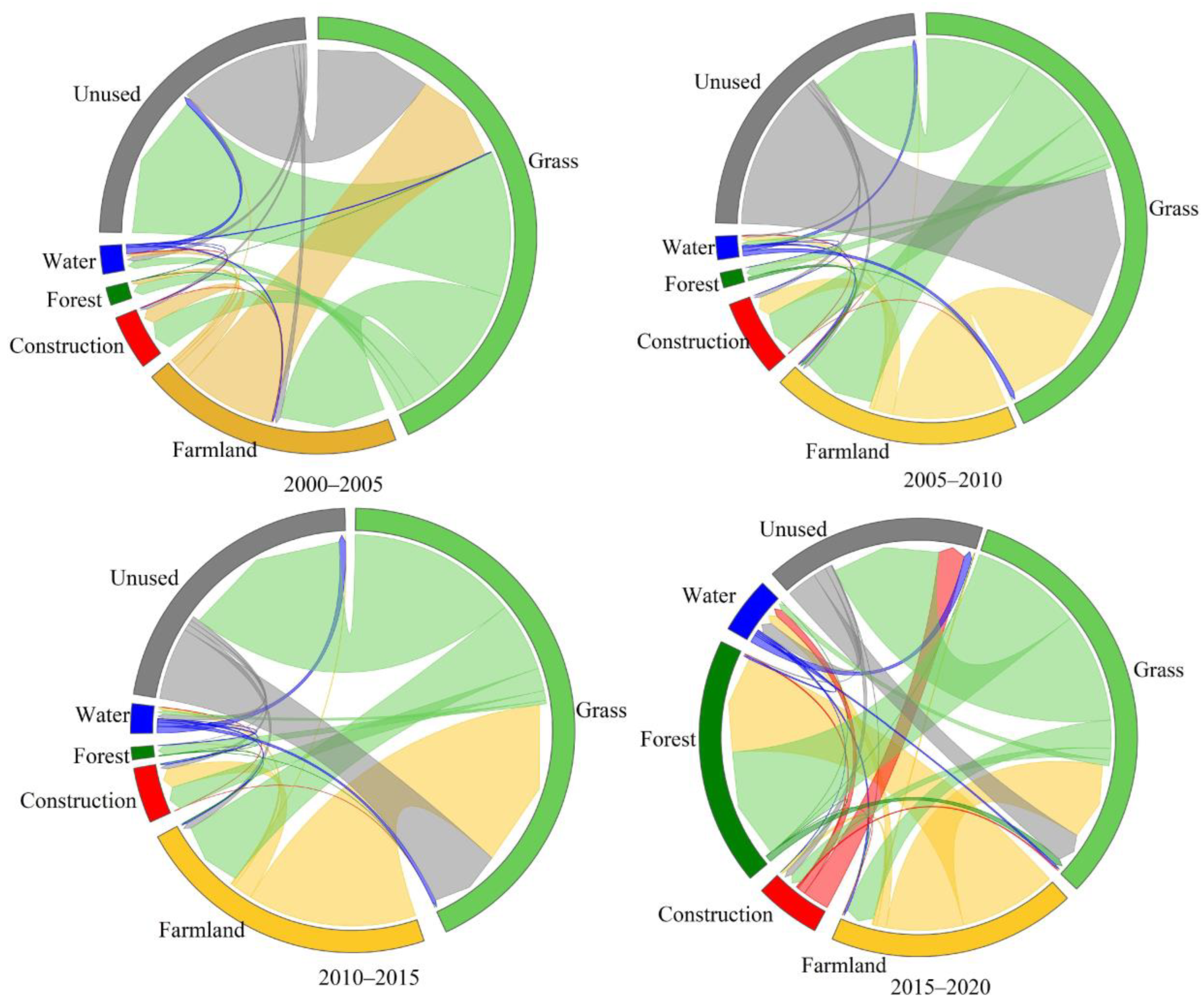
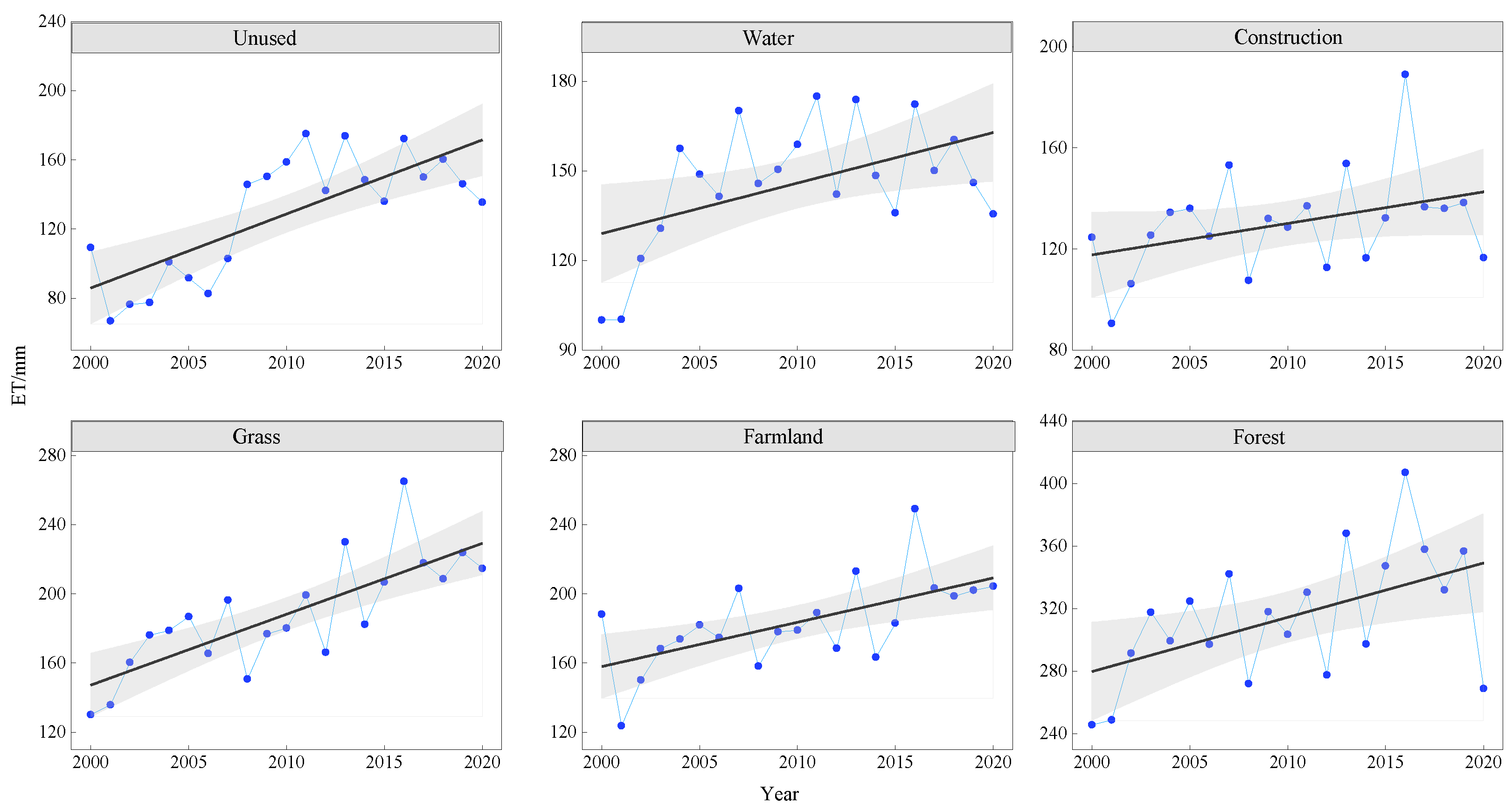
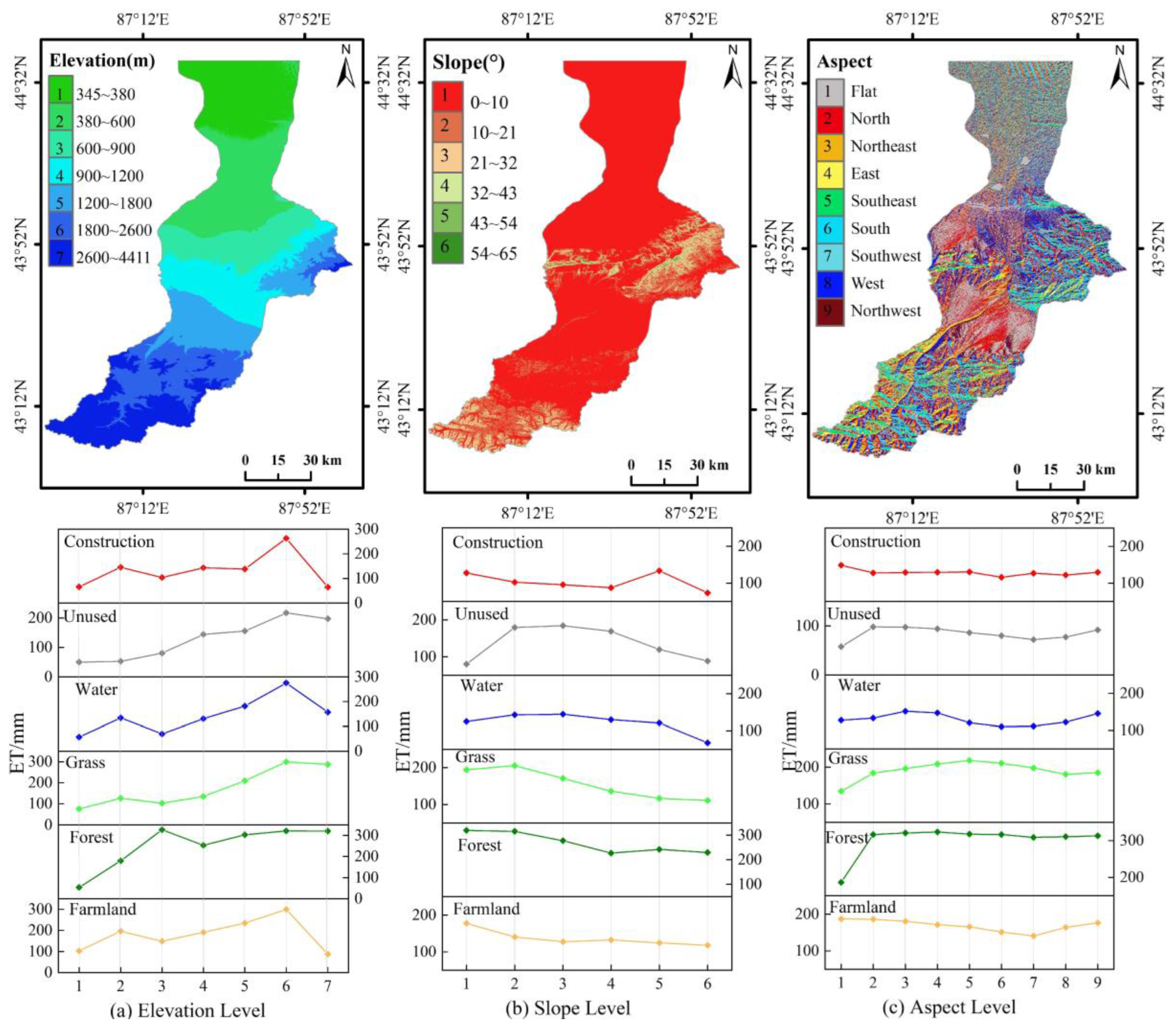
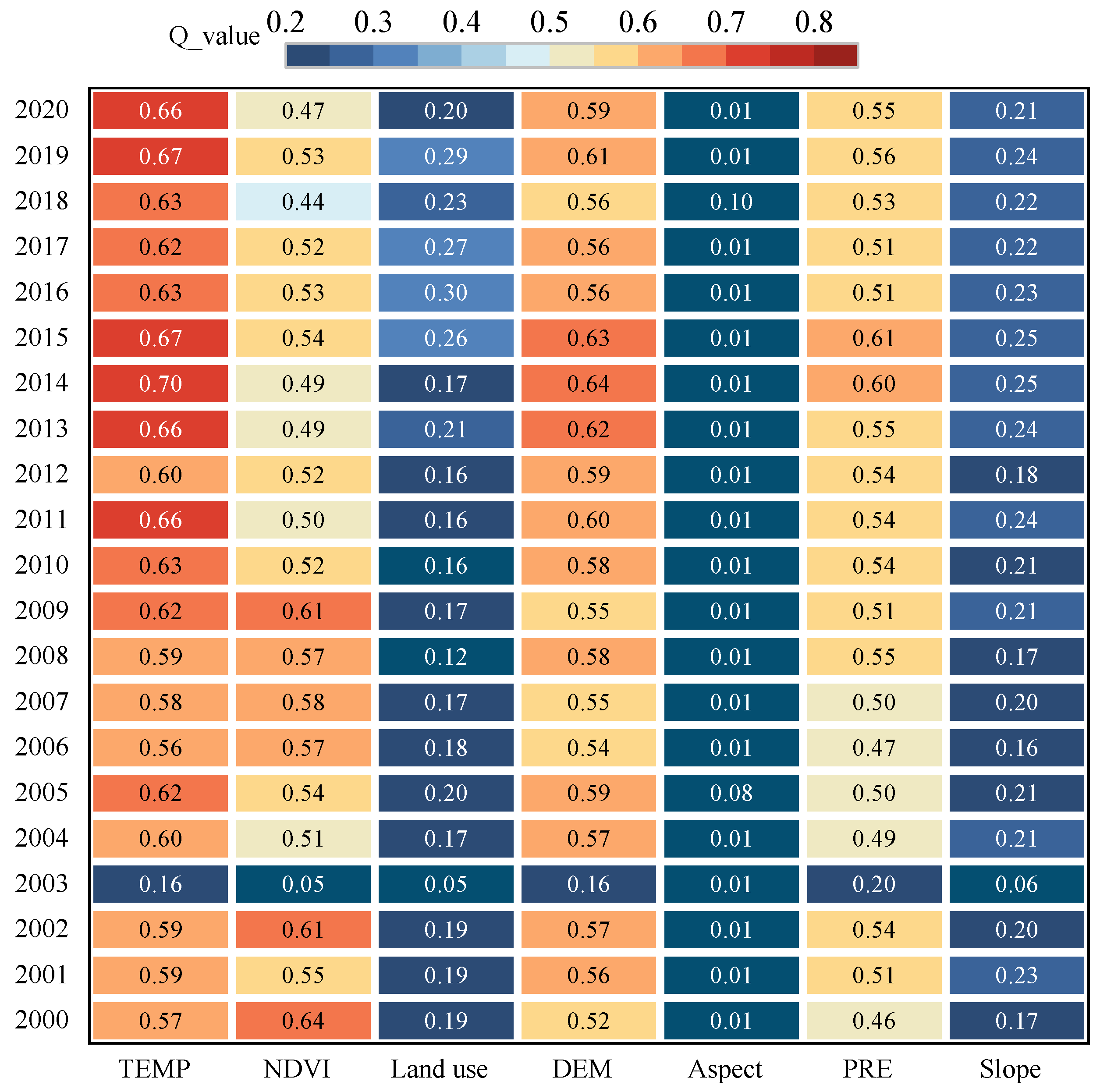
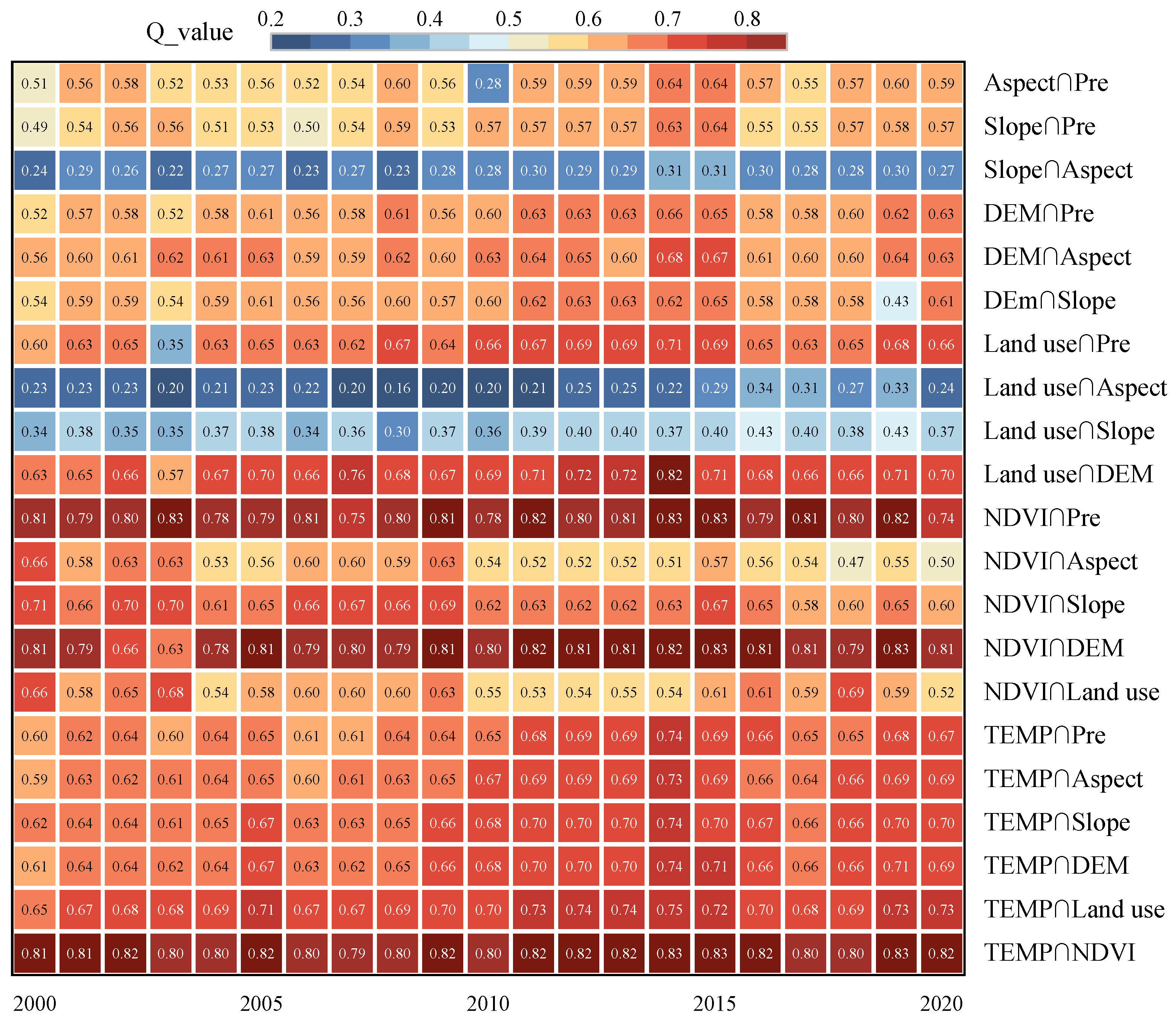
| Elevations Levels | Slop Levels | Aspect Levels | |
|---|---|---|---|
| 1 | <350 m | 0°–10° | Flat (−1 to 90°) |
| 2 | 350–550 m | 10°–21° | North slope (0 to 22.5° and 337.5° to 360°) |
| 3 | 550–900 m | 21°–32° | Northeast slope (22.5° to 67.5°) |
| 4 | 900–1200 m | 32°–43° | East slope (67.5° to 112.5°) |
| 5 | 1200–1800 m | 43°–54° | Southeast slope (112.5° to 157.5°) |
| 6 | 1800–2600 m | 54°–65° | South slope (157.5° to 202.5°) |
| 7 | 2600–4411 m | Southwest slope (202.5° to 247.5°) | |
| 8 | West slope (247.5° to 292.5°) | ||
| 9 | Northwest slope (292.5° to 337.5°) |
Disclaimer/Publisher’s Note: The statements, opinions and data contained in all publications are solely those of the individual author(s) and contributor(s) and not of MDPI and/or the editor(s). MDPI and/or the editor(s) disclaim responsibility for any injury to people or property resulting from any ideas, methods, instructions or products referred to in the content. |
© 2023 by the authors. Licensee MDPI, Basel, Switzerland. This article is an open access article distributed under the terms and conditions of the Creative Commons Attribution (CC BY) license (https://creativecommons.org/licenses/by/4.0/).
Share and Cite
Ablikim, K.; Yang, H.; Mamattursun, A. Spatiotemporal Variation of Evapotranspiration and Its Driving Factors in the Urumqi River Basin. Sustainability 2023, 15, 13904. https://doi.org/10.3390/su151813904
Ablikim K, Yang H, Mamattursun A. Spatiotemporal Variation of Evapotranspiration and Its Driving Factors in the Urumqi River Basin. Sustainability. 2023; 15(18):13904. https://doi.org/10.3390/su151813904
Chicago/Turabian StyleAblikim, Kamila, Han Yang, and Azimatjan Mamattursun. 2023. "Spatiotemporal Variation of Evapotranspiration and Its Driving Factors in the Urumqi River Basin" Sustainability 15, no. 18: 13904. https://doi.org/10.3390/su151813904
APA StyleAblikim, K., Yang, H., & Mamattursun, A. (2023). Spatiotemporal Variation of Evapotranspiration and Its Driving Factors in the Urumqi River Basin. Sustainability, 15(18), 13904. https://doi.org/10.3390/su151813904







